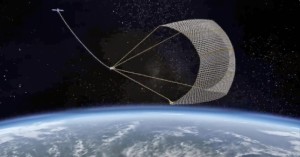Year by year, as the issue of orbital trash continues to unfold, how best to deal with management of space traffic becomes problematic. But where should the responsibility of space traffic management reside?
A new study — Space Traffic Management: Assessment of the Feasibility, Expected Effectiveness, and Funding Implications of a Transfer of Space Traffic Management – has been released by the National Academy of Public Administration (NAPA).

In-orbit explosions can be related to the mixing of residual fuel that remain in tanks or fuel lines once a rocket stage or satellite is discarded in Earth orbit. The resulting explosion can destroy the object and spread its mass across numerous fragments with a wide spectrum of masses and imparted speeds.
Credit: ESA
Complex underlying issues
“There is general agreement within the space community on actions that can address the complex underlying space traffic management issues facing the world of stakeholders deploying orbital assets. However, there are questions regarding where the responsibility for space traffic management should ultimately reside,” explains NAPA’s Teresa W. Gerton, President and Chief Executive Officer in a foreword to the report.
The NAPA report provides “clear recommendations” on how Congress and the stakeholder community “should expeditiously proceed to address the looming crisis in space. Taking prompt action will serve to greatly enhance important commercial and research enterprises connected with the endless expanse that lies above us,” Gerton adds.
Independent review
Thanks to the appropriations act for Fiscal Year (FY) 2020 in the Senate Amendment to H.R. 1158, Division B (116th Congress) appropriations were provided to the Department of Commerce (DOC) to contract with NAPA to conduct this independent review.
As noted in the over 120-page report: “There is a consensus across industry, academia, government, and the commercial sector that Congress must appropriate adequate funding for STM [Space Traffic Management]. The expectation is that investments and costs associated with carrying out this work should reflect specific outcomes: a safer space orbit, accountability for behaviors, and less risk.”
Furthermore, the report underscores the fact that the market that supports this outcome should be enterprising, accessible, and affordable.
Dynamic field
“Space commerce is a dynamic field,” the report stresses. “What it is today is not what it will be tomorrow and flexibilities regarding assuring appropriate funding requirements must also be fluid. The accelerated growth is at an aggressive pace as more actors enter into industry. The funding aspects for the civil agency to take a leading role in STM are just as critical.”
The NAPA appraisal focuses on four agency candidates “best suited” to take on the STM task: (1) the Office of Space Commerce (OSC), a part of National Oceanic and Atmospheric Administration (NOAA) inside the Department of Commerce (DOC); (2) Office of Commercial Space Transportation (AST), part of the Federal Aviation Administration (FAA) inside the Department of Transportation (DOT); (3) NASA; or (4) the Department of Defense (DoD).
Safer space domain
“In light of the complexities and diversity of STM tasks and functions, it is difficult to conclude in a simple manner that there is one agency to take on this function,” the NAPA review explains. “There is a clear emphasis throughout this report, based on this assessment, that these and other agencies must continue to work collaboratively now, and in the future, to achieve a safer space domain.”
All that as prelude, the NAPA report utilized an evaluative criteria with an expert panel determining that (enter drum roll here) the Office of Space Commerce (OSC) — a part of the National Oceanic and Atmospheric Administration (NOAA) inside the Department of Commerce – is “best suited” to perform STM tasks within the federal government.
Urgent call
In a recent tweet, Secretary of Commerce, Wilbur Ross, said: “The findings of the Senior Panel highlight the urgent call to action needed to ensure a safe and sustainable space environment to support a thriving U.S. and global space economy. We look forward to working with the Congress to quickly advance this critical space mission.”
To read the full report — Space Traffic Management: Assessment of the Feasibility, Expected Effectiveness, and Funding Implications of a Transfer of Space Traffic Management — go to:
https://www.napawash.org/uploads/NAPA_OSC_Final_Report.pdf
Also, go to this excellent overview of the report and its implications by Marcia Smith at SpacePolicyOnline.com at:






I think a bounty for space debris should be setup to encourage private enterprise to help clean up Earth orbits. The bounty would be funded by all entities that have caused this problem. The bounty system would be an international organization.
There are two problems here. First, defining and constructing the global organization of reducing what debris exists already and placing requirements on what is to be launched in the future. The Montreal Protocol that saved the ozone layer could be a very good model for identifying and reducing the most harmful debris. Secondly, deciding which country/organization will manage all this proliferated LEO (pLEO) constellation up and down activity. If pLEO plans work out by 2030 there will be about 10 reentries per day, many/most not controlled. Tracking them during their uncontrolled descent by drag through last 500 km of altitude will be critical.